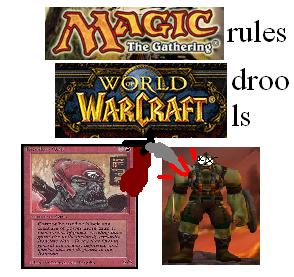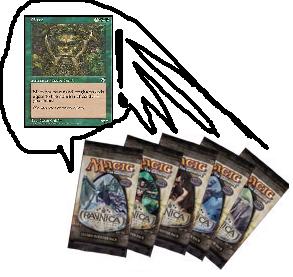"The longest journey is the journey inward."
-Dag Hammarskjold
Azeroth was nice, thanks for asking.

World of Warcraft is an amazing game, the problem is that instead of smashing the punk sitting across from you in a swift and brutal manner, you have to work with him 8 hours a day for weeks on end. After 3 months of being in what is arguably the 2nd best Horde guild in the game (Nightmare’s Asylum, Skullcrusher) I’ve come to realize that it’s not worth it. The time spent is equal to or even greater than Magic at whatever heights (or depths) you’re willing to aspire to, and the real world benefits are nigh non-existent outside of EBay. More importantly, the real world skills that are taught so well by Magic (poise under pressure, playing with confidence, and risk/benefit analysis to name a few) are not present. The only apparent benefit from playing WoW for 50 days out of the last 150 days of the year (besides a Warrior with enough epics to equip himself twice over in all purple gear) is that it’s much more difficult to frustrate me after dealing with a few of my more memorable guild mates. I don’t mean to knock the game, it’s amazing, but Magic is better.
Speaking of Magic, the new set is fantastic. I’m firmly entrenched in the pro-Rosewater camp (even if I mourn the loss of Counterspell) and this set fairly screams his name every time you rip open a pack. It’s the first set where we can assume that the format will actually be improved with each expansion, instead of the typical fond memories of triple Champions, or triple Mirrodin. It’s also a very smart set, there is a lot more to the format than just the four allied guild colors, and though at first glance venturing to non-allied territory may seem self-defeating, the road less traveled can be very effective. Today I want to talk about a color combination that most of us remember fondly from Champions and I think is back again in force — Blue/Red.

A quick overview of the format as those of us at Neutral Ground see it. Blue/Black mill is the best deck, Red is shallow (I guess some things never change), Red/White has issues killing people and Green/Black dredge is really good. The primary problem for us, especially as it relates to Blue/Red is that Red/White has problems finishing. Though kamikaze Red/White is really solid, if you lack Skynight Legionnaires, you can end up in a ground stall that Green/Black will dominate, and with Blue mages finding out how good Drift of Phantasms is, well, even the Skynight can be stymied. In short, hyper aggressive decks have their work cut out for them, and there is no Lava Spike to save you from the insurmountable 0/5 walls facing your army of 2/2 dorks.
On the flip side, Red/White really shines with a low curve and combat disruption, like Incite Hysteria and Master Warcraft. The mid-range pingers (especially Wojek Embermage as it lacks the body of Viashino Fangtail) end up feeling ineffective as they can’t compete with Green/Black’s bigger men, and they can’t even kill the Stinkweed unaided, so you have to rely on Thundersong Trumpeters and other two drops to exploit decks with a clunky mana base and a lot of CITP lands. Red remains a very strong color, no matter how shallow, but the best way to exploit its strengths isn’t with White, it’s with Blue.
Blue/Black has an exploitable weakness — its four slot is really crowded. Not only do you have Vedalken Entrancer competing with Induce Paranoia, there is also Dimir House Guard and both of the enchantments (Flight of Fancy and Strands of Undeath). Even though Snapping Drake is better than some of those cards, you don’t want to first pick it in a Blue/Black mill deck, and that leaves Blue/Red open to snag these as late as 2nd-4th pick. Another great card in Blue/Red goes late as well, Tidewater Minion is the cornerstone of this archetype, as it untaps your pingers and provides a huge body to trade with those pesky Golgari Rotwurms. Another strength of Blue/Red is its exploitation of bounce. Red’s pingers are all overcosted (Embermage because of radiance, and Fangtail because of its body) and as such can come online too late to stop Green’s convoke strategy. Blue’s bounce and countermagic (especially Convolute) can slow the game down by a few turns, which allows Fangtail and Embermage to dominate the board.
These are all reasons why Blue/Red functions as an archetype, but they are not its main strength. Its main strength is in exploiting the format’s new Glacial Ray — Galvanic Arc. Two cards, Mark of Eviction and Drake Familiar, can easily break the Arc, letting it go two or three for none and providing a swing that will remind you of splicing Glacial Ray onto itself. Bouncing the Arc with a Drake on turn 5, and then immediately recasting it, while holding a Mark of Eviction, is almost always game over, and even though Mark is uncommon, both Drake and Arc are not.
Before we get to the pick orders, a final note about the archetype. It’s a Tempo deck, but it’s aggressive. Even though the deck is based around the four slot, the bears are integral to the plan. A turn two bear is deadly in a format that allows for decks to be very aggressive with their mana bases, and the early damage will translate to less pings later on. Finally, white is your best splash in this deck. Not only can you get Auratouched Mage for your enchantments, but you can also boost up your pingers with Rally the Righteous. Based on the above, here is a rough pick order for Blue/Red.
Red
1st-3rd
Galvanic Arc — Pretty obvious by now.
Viashino Fangtail — Hill giant that pings, how can you go wrong.
Fiery Conclusion — Great removal spell that can kill Rotwurms and rares.
2nd — 4th
Sparkmage Apprentice — Solid ability that can go to the dome and kill x/1s.
Sell-Sword Brute — The bear you have to settle for. Take what you can get.
Dogpile — Another solid removal spell that can go to the dome but relies on bears.
5th — 7th
Ordruun Commando — Four power for four mana. Try to ignore the rest.
Wartorch Goblin — Solid little dork, he’s much better in R/W but I can see playing him here.
Sabertooth Alley Cat — Decent guy with evasion of a sort.
Viashino Slasher — A two drop.
8th+
Rain of Embers — Sideboard against convoke decks.
Rally the Righteous — Very good if you find yourself splashing white, but don’t force it.
Blue
1st — 3rd
Tidewater Minion — Huge guy, perfect on the curve, and has a great ability.
Snapping Drake — Perfect tempo card, three-power flyer for four.
Peel from Reality — Great bounce spell, cheap and another tempo card.
Drift of Phantasms — I agree with Eisel, a must for blue decks. Plus it transmutes into an Arc.
Vedalken Dismisser — Amazing card, buys you a ton of time, another tempo card.
2nd — 4th
Drake Familiar — This can drop to a much lower pick if you know you will get it back (which should be most of the time), but it’s power is undeniable in this archetype.
Vedalken Entrancer — Works with Tidewater, and it’s still a 1/4 for four.
Tattered Drake — Flyers are still flyers, this guy is more a 4th pick than 2nd pick though.
Convolute — Fits right on the curve in Blue/Red, another tempo card.
Compulsive Research — Fits on the curve and all around solid card drawer.
5th — 7th
Flight of Fancy — Great card that goes way up if you snag Hammerfist Giant or a few 4/x’s for 4.
Terraformer — Tricky little guy, I love him.
Induce Paranoia — Solid spell, the four slot is a little crowded though, hence my leaning towards Convolute.
Surveilling Sprite — Love this little guy, great to ping Snapping Drakes after blocking with him while drawing a card, or cantripping Fiery Conclusion.
Stasis Cell — Sometimes a necessary evil if the red removal somehow didn’t come together.
That’s the first time I’ve done such a detailed pick order and I intentionally overlapped the first 4 picks (1st-3rd and 2nd-4th). Even so I still don’t think it’s exactly clear. Why is Flight of Fancy so low for instance (mostly because you’re forced to pick up creatures to stay aggressive and enable Dogpile and Fiery Conclusion)? One aspect of the deck that might be a little clearer now that you’ve seen a rough pick order is the relative importance of each color. Red is what makes this deck tick, while Blue is the support. That means if you see Red open then Blue can be considered, but I don’t know if I would consider Red with Blue open. Red is very shallow, and it’s dangerous to seek out or force this combination as a result. I’ve gone something like 10-4 in the last few days with this archetype, but 3 of those losses were an 0/3 where I forced the archetype. You’ve been warned!
Hopefully this gives you a decent introduction to the archetype, and an understanding of how the different elements of Red and Blue combine to offset their weaknesses while highlighting their strengths. It’s an exciting time, being this early in the season, and new strides are being made every day in understanding this deceptively complex format. I hope this helped open your eyes to the possibilities of venturing outside the guilds.
The Magic Jerk
